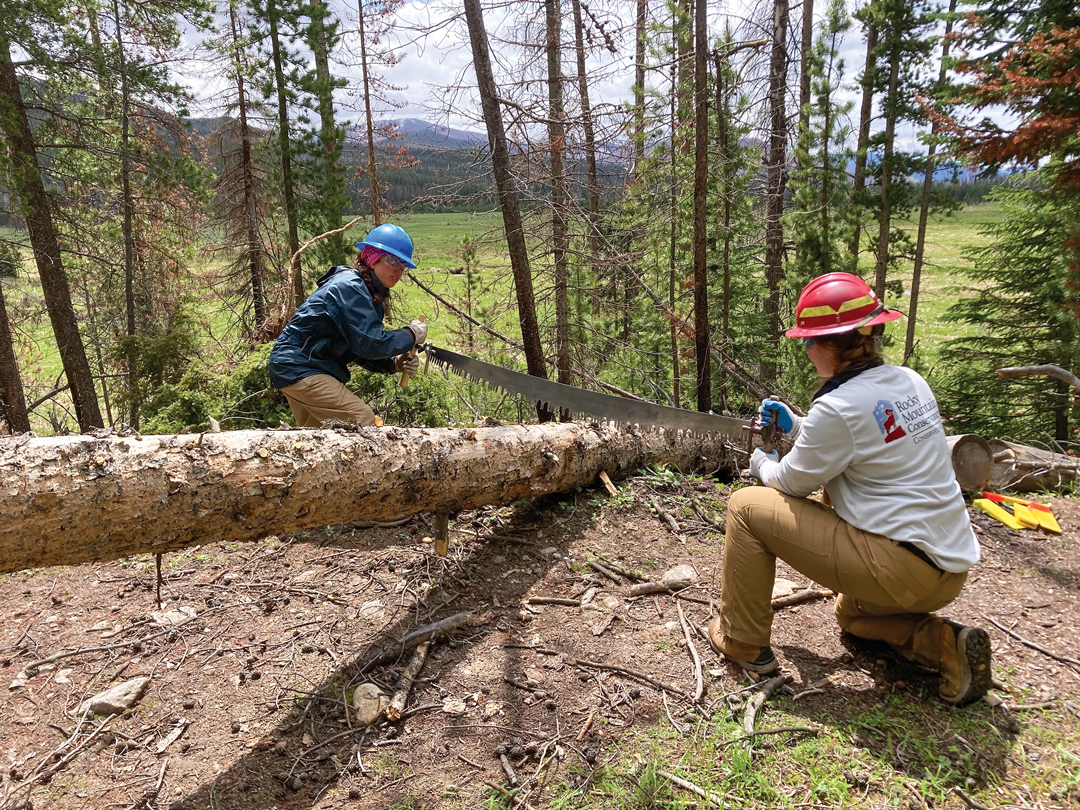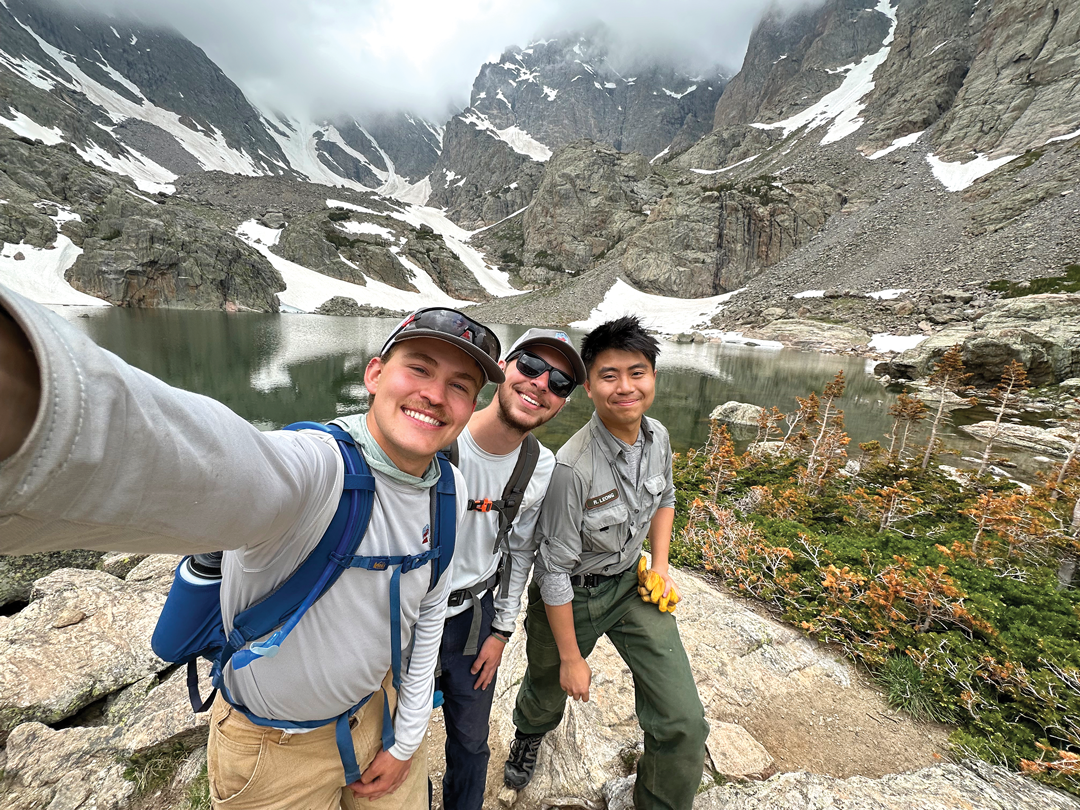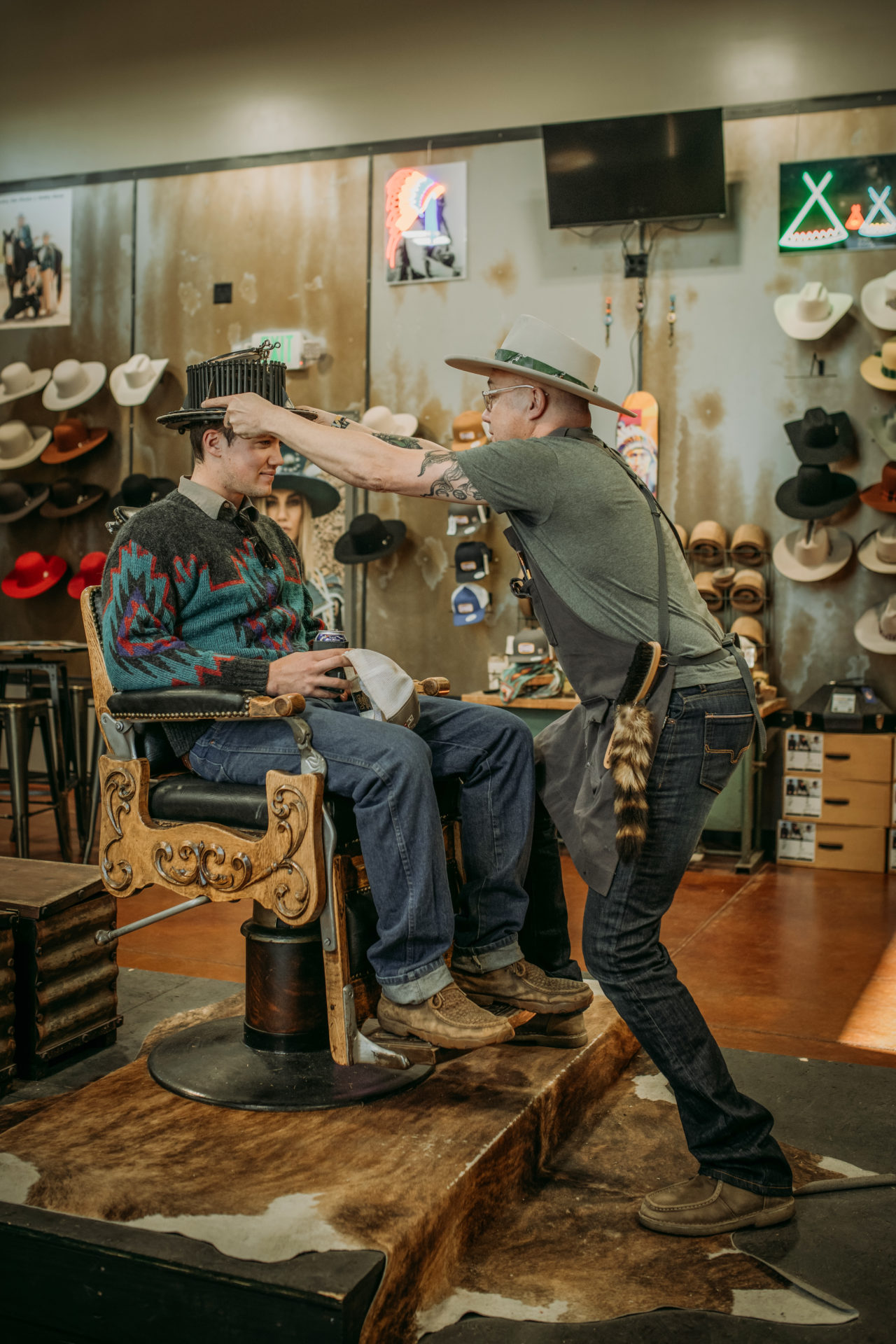There are adjectives people use to describe Sean Murphy, but quiet and reserved are not usually two of them.
He’s a trustee for the Town of Berthoud who has his own website and a twirly mustache, the kind you see in old Westerns. Being a trustee makes him a politician, and politicians are generally not reserved.
Yet quiet, even reserved, is how Murphy described himself before he spent a couple summers working for the Rocky Mountain Conservancy’s Conservation Corps. He grew up in Minnesota and went to college in North Dakota, two places where the cold seems to make people more subdued.
He was hoping to find himself, so he applied to the corps after listening to his father tell stories about working a summer in Glacier National Park, a time he called one of the greatest of his life. Murphy wanted that too.
The work was hard. Murphy spent his days rebuilding trails by hauling rocks and removing trees in Rocky Mountain National Park, but interacting with people of all backgrounds was harder for him as an introvert. At least it was at first.
Murphy grew to love the experience, and by the second year, when he was a crew leader, he was outgoing enough to hit it off with a pretty girl named Anna, who is now his wife.

The 2023 Corps Sulphur Crew earned a nationally recognized crosscut saw certification.
“It helped get me out of my shell and forced me to talk to all these different people,” Murphy says.
The park’s beauty influenced his professional pursuits as well. Many of the accomplishments he lists on his website are in some way related to sustainability, such as Berthoud’s new $2.5 million bike park. Anna, too, serves as a member of Berthoud’s Parks, Open Space, Recreation and Trails advisory committee.
Murphy says working with the crews from 2008-10 developed his skills so much as a human being that he doesn’t think he’d be a town trustee without having participated in the corps.
This is what corps leaders hope members take away from their summers. The corps, now in its 20th year, has changed its priorities.
“When I took over, I shifted it from a conservation corps that does hard work to a professional development program that works in conservation,” says Ian Stafford, director of policy and stewardship. “We don’t teach trail maintenance. We teach leadership, emotional training and how to work with groups where you might disagree with each other.”
Doing the dirty work
The corps began as a way to provide the national park with enough hands to get projects accomplished, not necessarily to provide life experiences for future town trustees.
The Rocky Mountain Conservancy has been the national park’s nonprofit partner since 1931, helping to raise money, sell merchandise and host classes that teach visitors to appreciate, care for and learn more about the park and its fragile habitat. In the early 2000s, the park admitted it could use some volunteers to pitch in on the hard work of maintaining its trails and facilities that were overrun by tourists.
The conservancy responded by forming a small group of younger (aka more energetic and stronger) volunteers to work in the Moraine Park area. The so-called Moraine Crew remains six strong and serves to update the trails in one of the park’s most popular spots to camp and watch elk.
The number of corps members has since grown to more than 50 per season. It’s competitive despite the hard work: Last year, the corps selected 55 members from a pool of 225 applicants. A couple years ago, there were just 60 corps applications.

David Boord (left) at Chasm Lake with Conservancy Corps and Rocky Mountain National Park staff.
The corps interviews and accepts young adults ages 18-30 (Stafford says it’s usually more like 18-25) because they’re still at uncertain stages in their lives.
“I really take pride in the fact that we take in anyone from any background,” Stafford says. “They want to go out and experience stuff. Maybe they have grandparents who live in Estes Park, and others have never camped before and then go camping for three straight months.”
The work is significant and usually benefits the public directly. In recent years, the corps was instrumental in rehabbing and reopening areas scorched by forest fires, including the massive East Troublesome Fire near Estes Park and the equally devastating Cameron Peak Fire in the Poudre Canyon. The corps is also in its final year of a five-year mission to build a new trail on the heavily used—some might say abused—path that leads to Longs Peak, the most popular mountain in Rocky Mountain National Park.
“We’ve talked to national forest staff, and they’ve all said they would not be able to do the work they do without the corps,” Stafford says.
Other corps projects include retiling grout in a visitor center, cleaning up the remnants of illegal and dispersed campsites and social trails up popular paths and removing invasive species in the park. The more common term for that is pulling weeds all day in fields covered in them.
“It’s not always the sexy stuff,” Stafford says.
The “sexy stuff” can be even harder. Longs Peak trail crews occasionally get homemade cookies, kudos and hugs from grateful hikers, but the work basically involves hauling rocks from one place to another in the thin air above treeline. Trail workers generally stay onsite, meaning they camp in all kinds of weather for days at a time. David Boord, a 2022 crew member and 2023 crew leader, describes some interesting experiences with lightning, though he never felt unsafe.
“We camped up there for eight days straight at times,” Boord says. “I was exhausted.”
Stafford says the ever-increasing visitation numbers mean his crews get even more kudos. The mitigation, some argue, just means more visitors come to the park.
“A lot of times the hikers passing trail crews are thanking our crew a lot,” Stafford says, “but that also means the work doesn’t end.”
Some perks and a pass
Members of the corps get a living stipend, though Stafford lists other perks as well.
They get a pass that allows them into any national park and federal recreation lands for a year, and they get some significant time off to enjoy it. Crews work for days at a time and then get four days off or more in a row. They get uniforms, including boots and gloves, and free housing for their entire stay, which is not common among other summer work experiences, Stafford says.
Some, not all, meals are provided, but it’s not like workers have to hunt squirrels on their days off. They even get to rent bougie equipment such as North Face sleeping bags, and they have the option to purchase them at cost (at least half off the retail price). This is important to some corps members who have never seen a mountain before and fall in love.
“The cost of getting outdoors is higher than we think,” says Anne Morris, communications associate with the Rocky Mountain Conservancy. “We want to remove those barriers by outfitting people.”
Boord went on a couple road trips during his two years with the corps, including one to Moab, Utah, and another to the Great Sand Dunes National Park and Preserve in Alamosa.
“That was my first-ever time in a dispersed campground and away from people,” Boord says.
The contacts corps volunteers make can lead to a career in the outdoors, even if that’s not what they were planning for, says Kaci Yoh, philanthropy director for the conservancy. The professional development, she says, is priceless.
“We don’t want you to come back for a second year,” Stafford says. “We want you to find an avenue to the forest service and the park service and go work for them.”
Boord, for instance, is studying environmental law at The George Washington University and has already made valuable contacts as a result. He did, however, find his second year valuable as a crew member.
“Some of the magic, the ‘la la la la la,’ was a bit gone,” Boord says. “But seeing crew members grow, and lead them, was one of the most rewarding things I’ve done.”
Indeed, Boord had many of the same experiences as Murphy. Many do, Stafford says, and it’s why he considers the corps more of a professional development opportunity than just hard work.
“It’s grit, dependability and being accountable for their actions,” Stafford says. “It’s building career opportunities.”
Highlights From the 2023 Season
1. Maintained nearly 300 miles of trails and cleared 1,150 drainage structures
2. Built six bridges and 640 feet of new trails
3. Constructed three rock retaining walls, two rock staircases and a climbing access trail across a talus field in the Indian Peaks Wilderness
4. Restored the Holzwarth Historic Site on the west side of Rocky Mountain National Park, including raising and stabilizing the cabin’s foundation, installing a new roof and siding and reconstructing the woodshed and fencing
5. Removed 657 hazardous trees
6. Cleared 160 acres of invasive plant species
7. Removed 12 illegal campsites
To support the Rocky Mountain Conservancy, visit rmconservancy.org and donate to the Conservation Corps fund, or sign up for the conservancy’s Field Institute seminars throughout the summer. Those interested in joining the corps can also apply on the website. 2024 crew member applications close on March 8, and the program runs from May 28 through Aug. 9.







